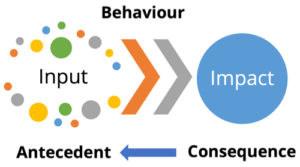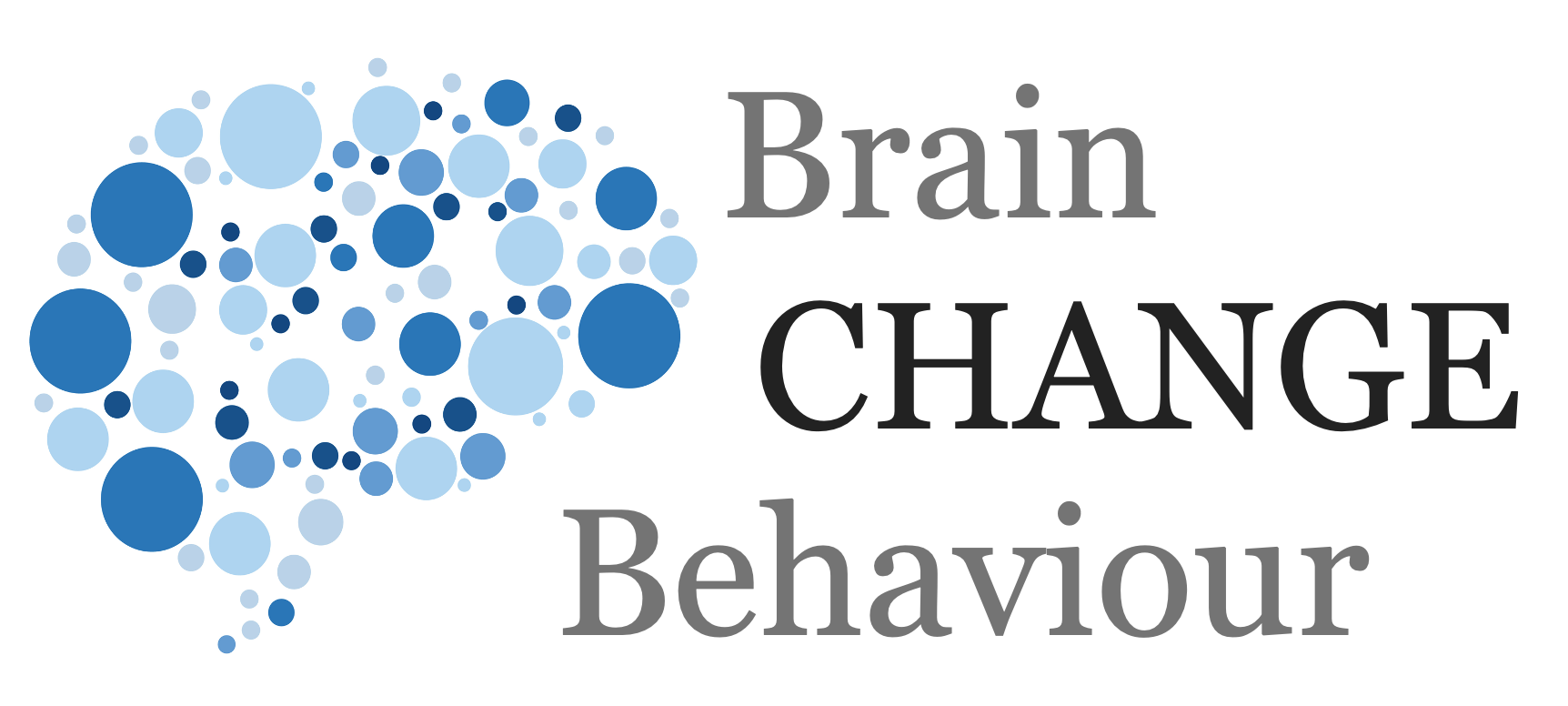The Knowledge – Level 1
What is behavioural change?
Behavioural change is about altering habits and behaviours in the long term.
Here we will mostly focus on how to influence, instigate, and guide behavioural change in corporate contexts that lead to building new or more beneficial habits in small and large groups in the workforce.
A simple model
 The antecedent is the input – what triggers a behaviour. This will be an environmental cue, and this will be influenced by habit, intention, and personality, amongst other things.
The antecedent is the input – what triggers a behaviour. This will be an environmental cue, and this will be influenced by habit, intention, and personality, amongst other things.
The behaviour is what comes from the antecedent, our focus. This can be an action of any sort. However, it could also be an emotion or intention that is triggered.
The behaviour will trigger an impact of some sort and this will have a consequence such as a positive outcome (reward) or a negative outcome (punishment). This will then feed back and update the “operating model” of this individual.
In this model we can see there are different things to change and some consultancies claim that one or the other is the most effective. Some say that changing the antecedent, for example by changing mindset, will make change more effective and lasting. Others say that changing consequences through things like reward and punishment will be more effective and is the biggest problem. The answer is, of course, it depends.
Antecedent
This will include environmental triggers, human impulses & natural drives, personality, and mindset. Can vary from easy, to difficult, to near impossible to change.
Behaviour
Behaviours can be many things but they can be changed be simply focusing on the behaviour. For example a lot of training focuses on simply changing a behaviour.
Consequence
Consequences feed back into behaviours and can strengthen them or weaken them. Therefore by changing consequences we can influence beahviour. This is often through reward and punishment systems.
All
The largest impact will be by changing all aspects. This may be necessary in many contexts. When we talk of “culture change” we will need to change all of these.
How?
Environment
Change the environment and we can change behaviours.
Instruct
The simplest and most common form – but if it works, it works.
Motivate
This involves tapping into indivduals personal drives and motivations to engage in behavioural change.
Guide
Guidance involves multiple inputs and this may vary from changing environment, to motivating, to changing reward structures.
Mandate
This involves forcing change through but needs authority and ways of enforcing this to make it work.
Who?

Individual
Some change involves only influencing one person. But that in itself can be challenging. It could be a difficult person. A high performer with a negative side. An old loyal employee who refuses to take on new stuff. Or a person who constantly puts the brakes on.
However, it is also easy to make a clearly individualised approach.

Small Group
Changing small groups is a common theme and normally revolves around business teams. Team dynamics can vary widely but can also be influenced pretty quickly.
Personalisation is key as is personality mapping – there are often surprises in this with some people being key to team performance but otherwise underestimated.

Large Group
The larger the group, the more challenges there may be and the more thought has to be given. There is also more room for unintended consquences and negative spillover.
Large groups require more thought and planning to guide behavioural change.

Population
Population-wide behavioural change initiatives face many challenges. Unintended consequences, negative spillovers, counter movement’s, organised opposition, loss of momentum, change fatigue. But also scaling problems, lack of resources, and changing dynamics within the population.
Therefore great care and thought needs to be given and/or a broad multi-pronged approach taken on.
What?

Individual Habit
We all know this, trying to change a habit. This are often relatively benign factors, our classic New Year’s resolutions. However, the success, or rather failure of these shows us how hard this can be.

Collective Habit
Collective habits are when groups of people, often in similar circumstances, such as in a business, collectively do the same thing, not necessarily for the benefit of the business.

Mindset
This is often used in the corporate space with leaders or change programes wanting a mindset change. But mindset is based on many factors so care must be taken.

Culture
A culture is a “big” concept – it includes a multitude of behaviours and attitudes. These often devleop randomly and without any external control – therefore changing in unpredictable ways.

Location
Location change is something we all, and many businesses, go through mutlitple times in our lives. Though considered realtively easy there are also multiple challenges to this – and benefits also.

Surroundings
Changing surroundings often changes behaviours and so can be used to drive behavioural change – but changes may also be random and unexpected.

Image
Changing an image is often done by companies and also individuals and involves a lot of change of external characteristics but also of behaviour.

Identity
Identity change is rarely discusssed – it is a big concept and very challenging. Identity is also what blocks many behavioural change initiatives or can turbocharge them to successs.
Where?

Home
Change begins at…home. Well this is a place where we see multiple behaviours that become habits and bad habits at that. Whether for yourself, your children, your partner, or extended family. Family life provides many good examples and challenges for behavioural change.

Business
Behavioural change is a common theme in business for multiple reasons. It is the main focus of this site. But it also provides challenges because there may be multiple influnces pulling behaviours in different, and often opposing directions.

Club
Sports clubs, associations, interest groups, have some clear alignment on one hand – a voluntary and internalised decision to be there and a unifying interest. But change and conflict can be a common theme and we can learn from the dynamics. Many clubs and associations may also need to change to stay relevant in a changing society.

Society
Behavioural change is a common theme in society. On one hand change is constant, on the other hand this may not all be positive or may be downright negative. Attempts may be made to change large population groups and this raises many, many challenges.
Articles
No Results Found
The page you requested could not be found. Try refining your search, or use the navigation above to locate the post.
